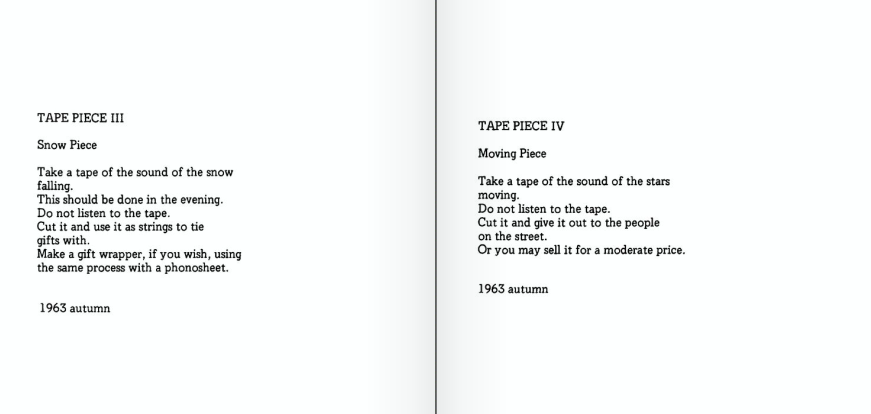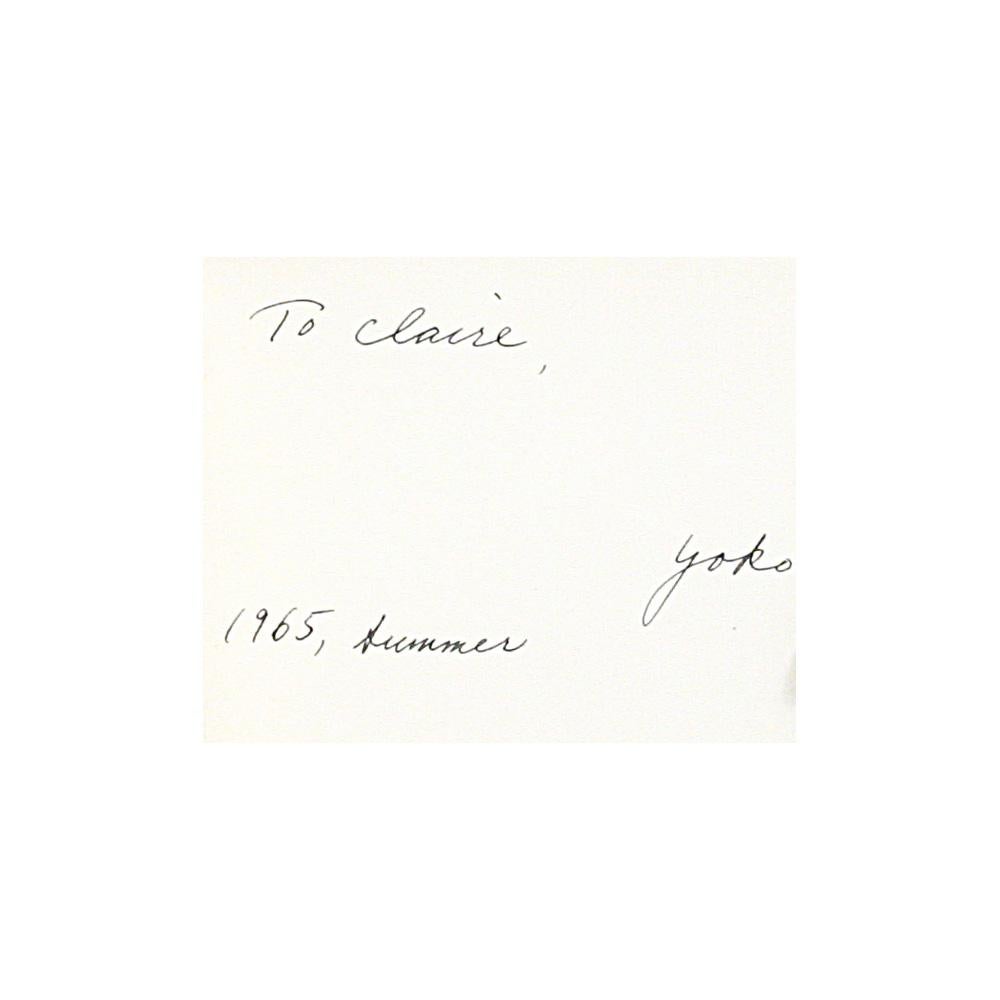

Keep stealing until no moon is seen on the water.” These instructions can be understood on multiple levels. Conceived in 1964, the card reads “Steal a moon on the water with a bucket. Each discrete card is a ladder to a place of affirmation, one that connects the imaginary and the real and asserts the power of the mind to create forms that occupy a liminal space between the material and the immaterial.

These instructions are reminiscent of Ono’s Ceiling Paining (Yes Painting) created in 1966, in which viewers climb up a ladder to arrive at a suspended magnifying glass that reveals the word YES painted on a canvas mounted on the ceiling. They ask their readers to follow instructions like imagine snow falling on people they converse with until that person is completely covered with imaginary snow, or draw a map of an imaginary place, follow that map to a specific point, and introduce themselves to the people they meet there. The scores contained in the original manuscript of Grapefruit are short, simply written directives, unassumingly printed using a typewriter on small, rectilinear cards. Grapefruit was initially published in Tokyo in 1965 as a limited edition of 500 copies and has been widely published multiple times since by Simon and Schuster and other major publishing houses around the world. In the mid-sixties, Ono complied many of her scores.
#Yoko ono grapefruit series
In 1962 she presented a series of performances at the Sogetsu Art Center in Tokyo centralized around asking the audience to construct “paintings” in their heads. The theme of “Do It Yourself” would continue to be central to Ono’s work, work in which Ono relinquishes control to of the artwork to the viewer, often seeking to instigate creative mental activity in the minds of others. Her instruction and performance pieces explored the limits of “painting,” and toyed with the notion that thoughts can act as art objects in themselves. Ono continued to create scores during this time. Maciunas published a series of absurd images printed on cardstock, accompanied by captions written by Ono entitled Do It Yourself Fluxfest. Ono also contributed event scores to the seminal Fluxus collection Maciunas published a few years later, An Anthology. Ono and Maciunas developed an intimate friendship and a professionally productive relationship and, in 1961, Maciunas held a show of Ono’s “Instruction Paintings” at the AG Gallery, which he co-owned. A burgeoning scene began to emerge surrounding avant-garde events and artistic collaborations, and it is around this time that Ono most likely met George Maciunas, the man who would become the central organizer and visionary behind the Fluxus movement. In 1961, Ono and La Monte Young hosted events featuring young artists experimenting with new notions of art and performance in Ono’s Chambers St. She was married briefly to Toshi Ichiyanagi, a student of Cage’s in his famed Experimental Compositions classes at the New School. Like Brecht and Young, Ono was influenced by the teachings of John Cage, whose ideas about indeterminacy and chance performance inspired many avant-garde artists working at the time. This interconnectivity between imaginative play and the physical manifestation of ideas is embodied in Ono’s pivotal work, Grapefruit, a collection of the “Instruction Pieces” she composed in the early 60’s, and speaks in significant ways to artists today trying to negotiate an effective relationship between ideas and praxis. Yet Ono’s whimsical and poetic scores seem to emerge from a place of greater spirituality, one that celebrates the power of the human imagination to construct beautiful and transcendent situations. Yoko Ono’s Instruction Pieces have often been discussed in relation to the Fluxus scores created by artists such as George Brecht and La Monte Young, and they certainly contain an element of the latter’s playful Dadaistic character.

With the emergence of relational art in the 1990’s and so much contemporary artwork that flirts with the idea of the creation of new societies, this art has sometimes enthusiastically, often critically, and always creatively begged the question of how it can be used towards the realization of a better world. Yoko Ono Grapefruit original manuscript on view for the first time, Stendhal Gallery, 2009


 0 kommentar(er)
0 kommentar(er)
